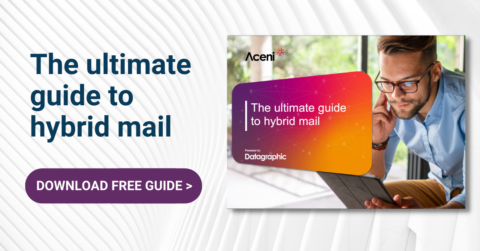Do you know the main benefits of hybrid mail technology? Read on if you’d like a more efficient way to send outbound communications.
At Datagraphic, we talk a lot about how technologies have been helping people work faster and smarter for decades.
One solution that continues to gain momentum and has accelerated in recent years is hybrid mail.
What is hybrid mail?
Hybrid mail is the generic name for sending mail using a combination of electronic and physical processes. It involves using software and the resources of a third-party mailing specialist to automate the manual processes of printing, posting, sorting, and dispatching letters and documents.
Why move to hybrid mail?
Hybrid mail solutions are an attractive option for forward-thinking organisations.
The technology automates outbound mail. The process of creating and sending customer mail, such as welcome letters, invoices, and statements, are no longer time consuming manual tasks.
By automating these processes, your teams gain back valuable time to focus on tasks that add greater value.
Aside from this major advantage, however, organisations see other significant benefits in choosing a hybrid mail solution.
What are the main benefits of hybrid mail technology?
#1: More agile hybrid working
Your team can access cloud-based solutions from anywhere.
For example, with our Aceni Hybrid Mail platform, users can carry out the required tasks from any geographical location with the correct access privileges.
#2: Improved data protection
You upload and store data on trusted centralised portals. This protects your data, such as employee data and contextual data, and ensures GDPR compliance, and files don’t need to be shared between your internal teams. Therefore, there is less potential for data breach risk.
To add further reassurance, your department heads can set up processes to create, check, and approve document production before anything is sent to the customer.
#3: Lower operating expenditure
As we’ve already said, you automate labour-intensive manual tasks to improve staff productivity.
There is also no need for an in-house mailroom. Consequently, there is no need to provide and maintain additional space, costly equipment, storage and consumables.
Like Datagraphic’s Aceni Hybrid Mail, Hybrid mail solutions are available with no capital expenditure for software or hardware.
#4: Lower postage costs
Good hybrid mail suppliers offer scalable platforms and give you the best postage rates with no minimum mailing thresholds.
Using a leading supplier, you could receive postage discounts that traditionally would only be available to organisations sending out more than 4000 mail items per day.
#5: Responsive same-day mailing
Manual tasks can be automated and completed quickly, in a fraction of the time.
Some suppliers, such as Datagraphic, offer a later cut-off time and same-day distribution. Therefore, your customer will receive your communication faster, without delay.
#6: Work more sustainably
From an eco-friendly and sustainability perspective, your organisation not only reduces paper wastage through on-demand ‘white paper’ production. It can also benefit from forward-thinking hybrid mail suppliers who pass on their sustainable credentials. For example, selecting recycled paper sources or offsetting their carbon emissions in the production process.
Which all means…
It’s faster, less expensive and more efficient than outdated manual internal communication methods.
So what are you waiting for?
Book a demo to discover how Aceni Hybrid Mail can take your organisation’s outbound customer communications to the next level.
Need to know more about hybrid mail?
Download our free ultimate guide to hybrid mail today.

